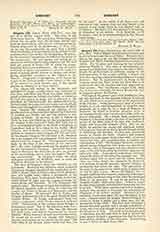

Gregory V, Pope, B. C. 970; d. February 4. 999. On the death of John X V the Romans sent a deputation to Otto III and asked him to name the one he would wish them to elect in the place of the deceased pontiff. He at once mentioned his chaplain and relation, Bruno, the son of Duke Otto of Carinthia and of Judith. He was already (996) distinguished for learning, especially for his knowledge of the dialects which were to develop into the languages of modern Europe. If possessed of a somewhat hasty disposition, he was nevertheless a worthy candidate for the papacy, and his election did honor to the Romans who elected him. This first German pope was consecrated May 3, 996, and his accession was generally hailed with satisfaction. One of his first acts was to crown Otto emperor (May 21, 996). Throughout the whole of his pontificate he acted in full harmony with his imperial cousin. Together they held a synod a few days after Otto’s coronation, in which Arnulf was ordered to be restored to the See of Reims, and Gerbert, the future Sylvester II, was condemned as an intruder. Unfortunately for himself and the peace of the Church, he prevailed upon the emperor not to banish from Rome the turbulent noble Crescentius Numentanus, “of the Marble Horse”. No sooner did Otto leave Rome than Crescentius roused his adherents to arms and Gregory had to fly to the north. Crescentius did not stop here, but caused an antipope to be proclaimed in the person of the crafty Italo-Greek John Philagathus of Roscano, who had artfully made a position for himself at the court of the Ottos and now took the title of John XVI (997).
At a synod which Gregory had ordered to meet at Pavia, not only were Crescentius and his antipope anathematized, but King Robert of France was threatened with excommunication if he did not put away Bertha whom he had married though she was related to him not only by spiritual relationship but by blood. After some opposition, Robert finally yielded, and, repenting of his misdeeds, repudiated Bertha and espoused Constance. Gerbert, too, after having been condemned by this synod also, abandoned the See of Reims, and was rewarded with the See of Ravenna. Furious that his authority had been so flouted, Otto marched upon Rome. Philagathus fled from the city and Crescentius shut himself up in the Castle of Sant’ Angelo. The emperor’s troops pursued the antipope, captured him, deprived him of his nose, ears, eyes, and tongue, and brought him back to Rome. There he was brought before Otto and the pope, and publicly degraded (998). Then, after being driven ignominiously through the streets of Rome on an ass, he was transported to Germany, where he seems to have died in the monastery of Fulda (1013). The castle of Sant’ Angelo was next besieged, and, when it was taken, Crescentius was hanged upon its walls (998). About the year 997, Archbishop 2Elfric came to Rome in order to procure his pallium, and to consult the pope about replacing the secular canons, who then held the cathedral of Canterbury, by monks, in accordance with the commission he had received from King Ethelred and the Witan. As a mark of special honor, Gregory put his own pallium on Aelfric, and bade him put into his monastery at Canterbury “men of that order which the Blessed Gregory commanded Augustine therein to place”. At the request of Otto, Gregory granted exceptional privileges to many German monasteries, and in his company held various synods for the regulation of ecclesiastical affairs. He had to threaten with anathema Ardoin, Marquess of Ivrea, if he did not make amends for his ill-treatment of the property of St. Mary’s of Ivrea, its serfs, and its bishop. Gregory V was buried in St. Peter’s “in front of the sacristy, i.e. on the Gospel side, near Pope Pelagius”.
HORACE K. MANN

